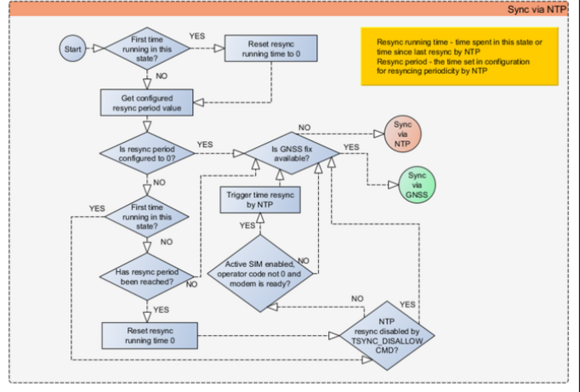FTC921 System
Ignition settings
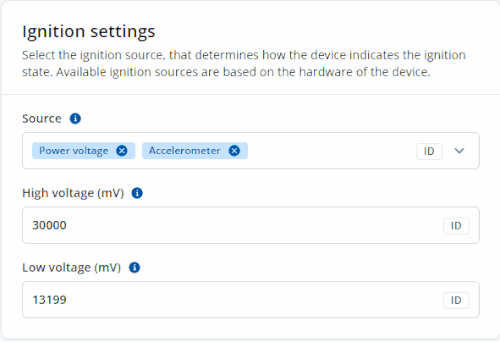
Ignition source will be used to determine the ignition status of the vehicle.
Possible ignition sources:
DIN 1 (Digital Input 1) - if DIN1 is 1 - ignition is ON; if DIN1 value is 0 - ignition is OFF
Power Voltage - if the voltage is between High Voltage Level and Low Voltage Level (below Ignition Settings options) - ignition is ON; if the voltage is higher than High Voltage Level or lower than Low Voltage Level - ignition is OFF.
Accelerometer - if movement sensor detects movement - ignition is ON; if movement is not detected - ignition is OFF;
More than one ignition source can be selected at the same time.
Note:
When there are 2 or more sources selected, at least one condition has to be met to change Ignition status.
For Example, if both accelerometer and power voltage are selected, only one of the ignition detection conditions have to be true for ignition to be detected.
Ignition status is used in power management and the following functionalities: Over Speeding, Trip and Odometer settings.
Movement settings
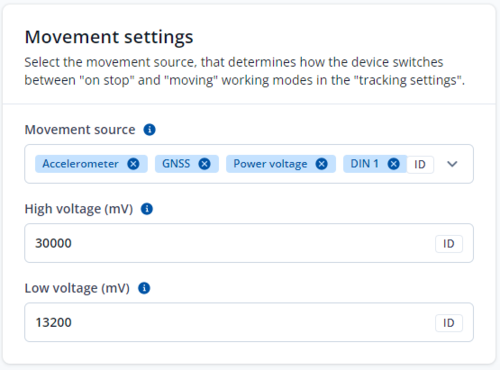
Movement source will be used to determine when a vehicle is on stop or moving.
Possible movement sources:
- Accelerometer (movement) - if the accelerometer detects movement, the Vehicle is under MOVING mode; if there is no movement detected, the Vehicle on STOP mode;
- GNSS - if GPS fix is acquired and speed >= 5 km/h vehicle then the MOVING mode is used; if GPS speed <5 km/h, the Vehicle on STOP mode is used;
- Power voltage - Data acquisition > "moving" mode (Parameter state = 1) - when power voltage is >= low power voltage and <= high power voltage. By default low voltage is 13.2 V and the high voltage is 30 V;
- DIN 1 - Data acquisition > "moving" mode (Parameter state = 1) - when voltage measured by DIN 1 is higher than 7.5V. Data acquisition > "on stop" mode (Parameter state = 0) - when voltage measured by DIN 1 is lower than 7.5V.
Configuration password
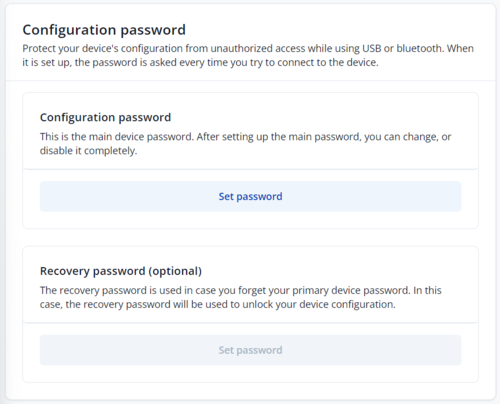
Protects the device from unauthorized access while using USB or Bluetooth to make any form of configuration changes.
- Set password - Set the primary password for the device. Required to access the device every time using the USB or via Bluetooth connection.
- Recovery password (optional) - in the event that the primary password is forgotten, the recovery password can be used as a backup to unlock the device configuration.
GNSS settings
In GNSS Source settings user can configure which GNSS system(s) to use.

List of configurable GNSS sources:
- GPS
- GPS + GLONASS
- GPS + Galileo
- GPS + BeiDou
- GPS + GLONASS + Galileo + BeiDou
Movement delay
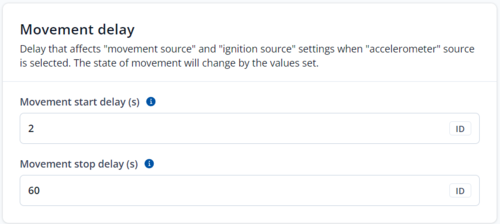
Movement delay will be used to set the timeout of delays when the accelerometer status changes.
Note: These settings impact the ignition/movement sources.
The user can set:
- Movement start delay (s) - movement start delay in seconds;
- Movement stop delay (s) - movement stop delay in seconds;
Power Saving settings
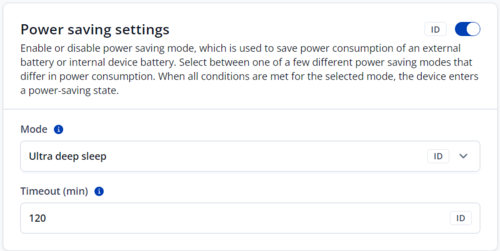
Puts the device into a power-saving mode, preserving the power consumption from the external source or the internal battery. The device enters this mode after the conditions are met.
- The selectable modes are as follows:
Disable - Normal mode, no internal battery saving.
Ultra Deep Sleep - The device turns off almost everything to save maximum power. The device exits this mode when DIN turns 1 (ON).
- Timeout - After timeout is reached, and conditions are met for the sleep mode, the device goes into sleep mode.
Time synchronization settings
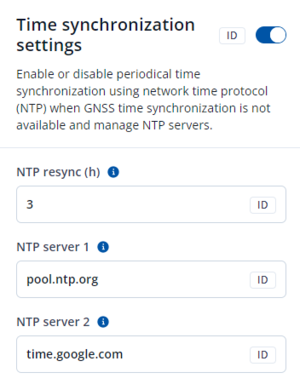
NTP Resync parameter determines how often a device should resynchronize its time. If the set value is not equal to zero, time resynchronization will occur periodically at time intervals to which this parameter is set.
NTP server 1 and NTP Server 2 let the user select which NTP server (s) will be used to re-synchronize time.
Time synchronization works by waiting a minute on startup to acquire fix and consequently synchronizes the time via GNSS.
This state checks the difference between RTC and GNSS times every second. If the difference of at least 3 seconds persists to be for 5 seconds, the firmware triggers a re-synchronization procedure by GNSS.
After that, the time difference is still calculated, but the difference is expected to persist for at least 5 minutes to trigger a GNSS time re-synchronization.
In the case that there is no fix or it is lost during the syncing by GNSS state, the firmware goes to the state of syncing by NTP. Entering the state of NTP syncing, the firmware immediately attempts to synchronize the time by triggering NTP and later on, does this periodically every time the configured NTP re-synchronization time is reached (if the re-synchronization time is set to 0 – no NTP sync is performed at all). Time synchronization by NITZ can occur at any time.
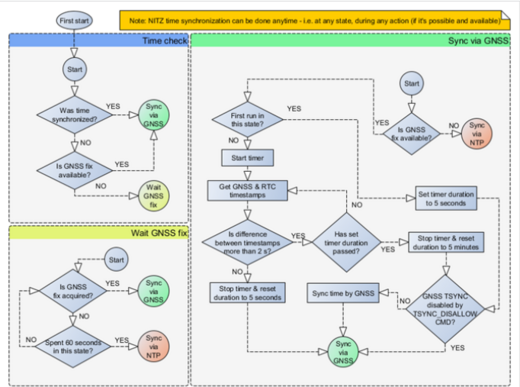
Battery settings
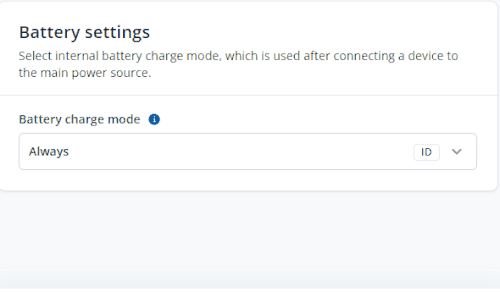
Battery settings allow selecting battery charge modes.
Possible charge modes:
On need—Battery will charge on need
After ignition ON—Battery will start charging when the ignition source is turned ON
Always—Battery will charge all the time
LED settings

This feature allows disabling or enabling status and navigation LED's

